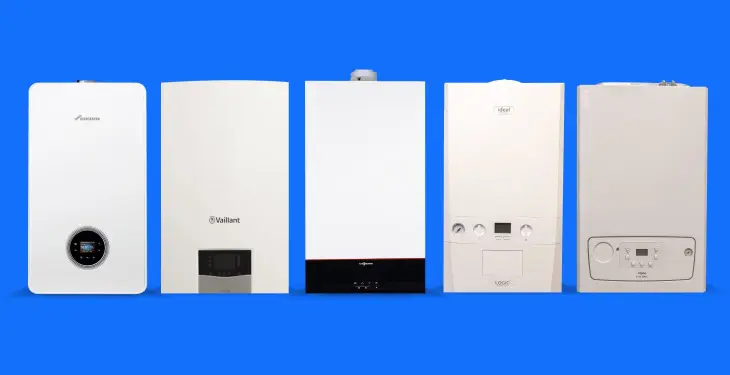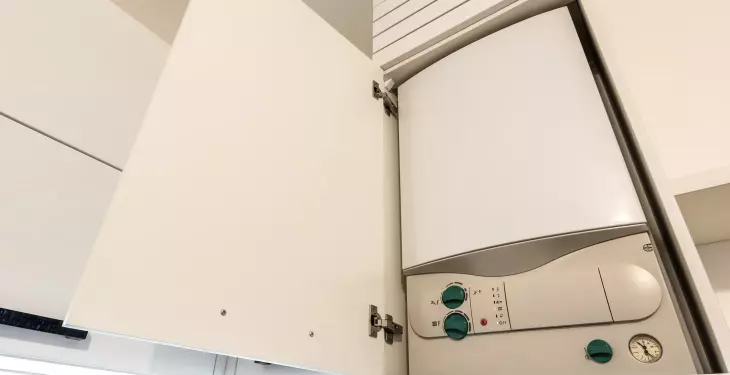

Written by Stephen Day
Gas Safe Engineer
Updated: 14th October, 2025
Maintaining the correct boiler pressure is essential for the efficiency and longevity of Worcester heating systems.
Get a new boiler quote, save up to £550 per year (0% APR available).
Maintaining the right pressure in a Worcester boiler is essential for efficient operation and longevity of the system. The ideal pressure range for a Worcester boiler, when the heating system is cool and inactive, is typically between 1 and 1.5 bar.
Homeowners may occasionally find the pressure to be too high or too low, both of which can impact the functionality of the boiler and in some cases, the safety of the household. Understanding how to check the pressure, what the readings mean, and how to respond accordingly is vital for any Worcester boiler owner.
If a boiler's pressure drops below 1 bar, it indicates that water has been lost from the system and needs replenishing — a task that most homeowners can perform without professional help.
On the other hand, pressures exceeding the normal range usually require a more in-depth assessment, as they may signal an underlying issue that needs addressing. Regular monitoring and maintenance of boiler pressure are therefore key components of effective Worcester boiler care, potentially preventing costly breakdowns and ensuring efficient energy use which translates to savings on energy bills.
Get a quote in 60 seconds, fitted as fast as next day!
0% APR finance available.
If your Worcester boiler is no longer maintaining pressure or is becoming costly to repair, our guide to new boiler cost explains what you can expect to pay for a replacement and installation in 2025.
Maintaining the correct boiler pressure is essential for the efficiency and longevity of Worcester heating systems. This section sheds light on what boiler pressure is and how it impacts the overall heating system.
Boiler pressure refers to the force with which water circulates within the heating system's pipes and radiators. Worcester boilers typically display this pressure on a pressure gauge, which is often located on the boiler's front panel. The optimal pressure range for operation is between 1 and 2 bars, which is when the central heating is turned off and the radiators are cold.
Pressure Gauge Reading: When the system is cold, the gauge should read between 1 - 1.5 bar.
Cold System Reading: The presence of red zones on the gauge indicates too low or too high pressure.
Regular Monitoring: Homeowners should regularly check to ensure that the gauge indicates within the green zone.
The pressure within a Worcester boiler is pivotal to the operation of the heating system; too low or too high pressure can lead to inefficiencies or potential breakdowns.
Low Pressure: A drop below 1 bar might signify a leak or the need to repressurise the system. Homeowners should then top up the pressure.
High Pressure: If the pressure gauge exceeds 2.75 bars, the system is overpressurised, often requiring bleeding of radiators or release of excess water through the system's pressure relief valve.
Monitoring the pressure gauge and knowing what the readings imply allows homeowners to maintain their heating systems effectively, guarding against undue wear and ensuring optimal performance.
Maintaining the correct boiler pressure is essential for the efficient operation of a Worcester boiler. This section will carefully detail how to identify when the pressure is too high or too low and provide step-by-step solutions for troubleshooting fluctuations.
High boiler pressure in a Worcester boiler can cause operational issues and may lead to long-term damage if not addressed. Ideal boiler pressure for these units typically ranges between 1.5 and 2 bar. Should the gauge indicate a pressure above 2 bar, especially if it is in the red zone, this signifies an excess. A likely culprit is the pressure relief valve (PRV), which could be releasing water due to overpressure or may have become defective. Alternatively, an expansion vessel problem might be present, failing to accommodate the increased volume of water as it heats and expands, thus causing the pressure to rise.
Quick checks:
Ensure the heating system is not operating at the time of pressure checking.
Observe the pressure gauge for a reading higher than 2 bar.
Steps for resolution:
Turn off the boiler and allow it to cool.
Bleed the radiators to release excess pressure. Catch any expelled water with a towel or container.
If pressure does not stabilise, consult a professional engineer to check the PRV and expansion vessel.
Conversely, Worcester boiler pressure too low can lead to the boiler failing to operate. The pressure gauge reading below 1 bar indicates insufficient pressure. Typically, this might result from water leaks within the system or after bleeding radiators without repressurising the system. The boiler's efficiency can be hampered, which could prevent it from providing heating and hot water.
Quick checks:
Ensure there is no water leakage from the system's components.
Read the pressure gauge; a reading below 1 bar requires action.
Steps for resolution:
Locate the internal filling loop, often identifiable by a blue lever.
Pull down on the blue lever to repressurise the system. Monitor the gauge until it reaches just over 1 bar.
Once the ideal pressure is achieved, release the lever and check the system returns to normal operation.
Should a Worcester boiler display frequent or erratic pressure fluctuations, several steps can ensure the system returns to stable operation. Initially, check for any visible leaks and the condition of the pressure release valve. Regular servicing by a certified technician is recommended to prevent and rectify these issues.
Investigative steps:
Examine the boiler and its surroundings for any signs of water leaks.
Check the PRV and expansion vessel for proper functioning.
Professional intervention:
Schedule an annual boiler service to identify and fix any potential issues.
If fluctuating pressure persists, a professional might need to recalibrate or replace the pressure gauge or investigate internal boiler components.
By adhering to these guidelines, most pressure-related issues with Worcester boilers can be efficiently resolved, promoting a longer life span and improved performance of the heating system.
Maintaining correct pressure in your Worcester boiler is essential for efficient operation. Here is how to re-pressurise your system using either the external filling loop or keyless filling loop, as well as how to adjust pressure by bleeding radiators.
Worcester boilers may require repressurisation through an external filling loop. This process involves connecting a hose to allow water from the mains system to enter the heating system. Follow these steps:
Locate the external filling loop, typically found below the boiler.
Ensure the boiler is off and cool.
Attach the filling loop to the connection points.
Open the valve slowly, allowing water to enter the system; you will hear water flowing.
Keep an eye on the boiler's pressure gauge.
Once the gauge reads approximately 1.5 bar, close the valve.
Detach the filling loop and store it safely.
If your Worcester boiler is equipped with a keyless filling loop, the repressurisation steps are slightly different:
Locate the filling link, which might be a blue lever beneath the boiler.
Ensure the heating system is switched off.
Lift or turn the lever gently until you hear water flowing.
Watch the pressure gauge; stop once you reach the 1.5 bar mark.
Return the lever to its original position.
Sometimes, air trapped in radiators can cause pressure fluctuations. Bleeding radiators may help in re-balancing the pressure:
Turn off the heating system and wait for the radiators to cool.
Use a radiator key to turn the valve at the top of the radiator.
Once the hissing of air ceases and water starts to dribble out, close the valve.
After bleeding all necessary radiators, check the boiler pressure. If it's low, you may need to repressurise the system following one of the above methods.
Regularly monitoring and maintaining the correct pressure will help ensure your Worcester boiler functions effectively and efficiently.
Routine maintenance and the prevention of boiler pressure issues are paramount to ensuring the longevity and efficiency of your Worcester boiler. Addressing problems like leaks, monitoring the expansion vessel, and establishing regular professional servicing are effective strategies for averting pressure-related complications.
Regular check-ups are vital to maintain your Worcester boiler's performance. Homeowners should inspect:
Radiators for even heating and absence of cold spots, which may indicate air trapped in the system.
Valves, to assure they are not leaking and are functioning correctly.
The installation of a Greenstar system filter can help to protect the boiler by filtering out debris and reducing the risk of blockages and wear on components.
The expansion vessel is a critical component that accommodates water's expansion as it heats up. Signs that your expansion vessel might need attention include:
A noticeable drop in pressure, which might suggest the vessel has lost its charge.
Water discharging from the pressure relief valve, an indication of an over-pressurised vessel.
Regular checks should ascertain that the vessel's pressure is in line with the manufacturer's specifications.
Enlisting a Worcester Accredited Installer or a Gas Safe registered engineer is indispensable for:
Comprehensive checks to detect any potential leaks in the system that might lead to a loss in pressure.
The repair of complex components, such as the expansion vessel, to ensure they are in optimal working order.
Assurance that all servicing and installation procedures meet legal and safety standards.
A professional service performed annually not only prevents abrupt boiler failures but also keeps the warranty valid.
Worcester Bosch, a leading manufacturer in the UK heating market, offers a range of boilers designed to suit various household needs. Precise pressure settings are integral to the seamless operation of these systems.
Greenstar 1000 and Greenstar 2000 are prominent models within the expansive Greenstar series. Typically, these boilers operate efficiently at a water pressure between 1.5 and 2 bar. They are characterised by their user-friendly controls and energy efficiency, often making them the boiler of choice for UK households.
Greenstar 1000: Renowned for its reliability, this model is tailored for small to medium-sized homes. It maintains a standard pressure setup in line with the Greenstar series.
Greenstar 2000: A step up in the series, it offers more capability to cater to a broader range of domestic requirements, maintaining similar pressure parameters to the 1000 model.
For larger properties, the Danesmoor Utility boilers present a robust solution, engineered to handle higher demands while maintaining consistent pressure levels as per the specific model guidelines.
Certified Worcester Bosch Accredited Installers are trained to install and set up these models following exact manufacturer specifications. They ensure that the pressure setup adheres to the predefined parameters for optimal functioning.
Worcester Bosch is one of several top-rated heating manufacturers in the UK. You can explore how it compares to other leading names in our full guide to the best boiler brands.
Members of the Excelerate program, who are accredited installers, have access to enhanced support and resources, empowering them to execute installations with an additional layer of expertise.
Here is a simple pressure guide for Worcester Bosch boilers:
Model Series | Optimal Pressure Range | Notes |
Greenstar 1000 Series | 1.5 - 2 bar | Suited for small to medium-sized properties |
Greenstar 2000 Series | 1.5 - 2 bar | Designed to accommodate a wider range of use |
Danesmoor Utility | Specific to model | Made for larger homes with higher demands |
Should these boilers experience pressure issues, such as falling below the optimal range, accredited installers can promptly diagnose and rectify the problem, thus ensuring continuous heating and hot water supply.
Ensuring safety and compliance in the operation of Worcester boilers is paramount. Key elements include the employment of Gas Safe registered engineers and the correct functioning of pressure safety valves to prevent dangerous situations.
A Gas Safe registered engineer is the only individual legally permitted to install, maintain and repair your boiler in the UK. They must carry a Gas Safe ID card, which verifies their qualifications and the types of gas work they are certified to perform. This assurance is not merely procedural; it is a critical safety measure to prevent hazardous situations arising from improper handling of gas appliances.
Legal Requirement: Only Gas Safe registered engineers can legally undertake gas work.
Safety Check: They perform essential checks to ensure the boiler operates safely.
The pressure relief valve, commonly known as the pressure safety valve, is a crucial component designed to maintain the boiler's pressure within safe limits. If the internal boiler pressure becomes too high, the valve releases water to lower the pressure, thereby averting the risk of explosion or other dangerous scenarios.
Pressure Regulation: It automatically releases excess pressure.
Safety Feature: Acts as a failsafe to protect the boiler and surroundings.
Each boiler system is configured to operate within a specific pressure range, usually between 1 and 1.5 bar when cold. It's imperative to regularly monitor the pressure gauge and consult a professional if drastic deviations are observed.
Improving a boiler's efficiency is not only about conserving energy; it's also about achieving substantial cost savings. By choosing a modern A-rated condensing boiler and implementing thermostatic radiator controls, homeowners can significantly reduce their energy consumption leading to lower fuel bills, even amidst rising fuel prices.
Selecting an A-rated condensing boiler is a pivotal decision in reducing household energy costs. These boilers are designed to capture a greater amount of heat that would usually escape out of the flue with older G-rated boilers. The Energy Saving Trust recognises A-rated condensing boilers to be over 90% efficient, a stark contrast to older G-rated models which may operate at only 60-70% efficiency. Such an upgrade can translate into fuel savings and reduced carbon emissions.
Efficiency: Over 90% for A-rated vs 60-70% for G-rated
Fuel Savings: Notable decrease in gas consumption
Investment: Costs offset by lower energy bills over time
Bosch Thermotechnology Ltd, known for its Worcester boilers, continues to innovate in the space of high-efficiency heating solutions.
To find the most efficient and reliable models available this year, read our 2025 guide to the best combi boilers for performance, warranty, and long-term energy savings.
Enhancing a heating system with thermostatic radiator controls (TRVs) allows for fine-tuning temperatures in individual rooms. This not only provides added comfort but also ensures that no energy is wasted heating unoccupied spaces. By adjusting the radiator output with TRVs, they work seamlessly with the boiler's programmer and room thermostat to optimise the heating schedule.
Tailored Heating: Adjust room temperatures individually
Energy Savings: Prevents overheating and minimises energy use
Compatibility: Works with existing heating systems and programmers
When used correctly, thermostatic radiator controls can lead to marked financial savings, particularly during the cold months when heating demands peak.
Deciding to replace a boiler can be driven by issues such as frequent breakdowns or inefficiencies in heating performance. Below is an overview of the financial aspect when considering a new boiler installation.
Last updated: 14th October, 2025

Written by Stephen Day
Gas Safe Engineer at iHeat
Stephen Day is a Gas Safe registered and FGAS certified engineer with over 20 years of hands-on experience in the heating, cooling, and renewable energy industry, specialising in boiler installations, air conditioning, and heat pump systems.
LinkedInArticles by Stephen Day are reviewed by iHeat’s technical team to ensure accuracy and reliability.

19th December, 2025
The best budget boilers are Ideal, Alpha, Baxi, Worcester Bosch and Vaillant models, compa...
 Read Article
Read Article

19th December, 2025
The most reliable boiler brands in the UK: Worcester Bosch, Vaillant, Ideal, Viessmann, an...
 Read Article
Read Article

19th December, 2025
An airing cupboard is a heated storage space that uses warmth from a hot water cylinder or...
 Read Article
Read Article
No obligation. Takes less than 60 seconds.